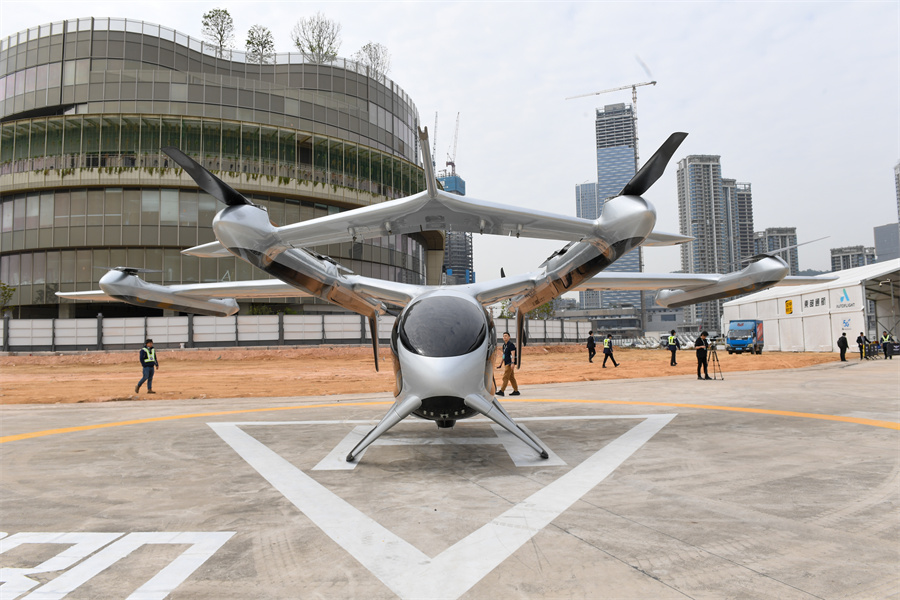Breaking barriers: Accelerating the future of Advanced Air Mobility


With some of the biggest names in the electric vertical take-off and landing world exhibiting at January's Consumer Electronics Show in Las Vegas, and the success of the first inter-city air-taxi demonstration from Shenzhen to Zhuhai, it's clear that the age of the flying taxi is rapidly approaching, but just how close are we to really embracing the low-altitude economy with Advanced Air Mobility?
Morgan Stanley forecasts this emerging sector to be worth in excess of $1.5 trillion by 2040, and in anticipation of this rapid growth, many countries have set aggressive timetables for the rollout of AAM services. In China, the Civil Aviation Authority of China took the bold step last October of becoming the first in the world to approve EHang's EH216 twin-seater eVTOL vehicle for autonomous flight. Volocopter, a German aircraft manufacturer, has completed production setup for their electric air taxi and is in preparation for their deployment in a variety of commercial applications across the world.
Overcoming market hurdles
Exciting times are clearly on the horizon, with East Asia well positioned to take advantage of early adoption, but skeptics continue to point to obstacles in the road to mass adoption for these new aerial technologies.
While vehicle developers across the globe race toward overcoming the engineering challenges, many point to the slow-burn of regulatory change that inevitably comes with a new mode of transport – particularly in the safety conscious world of aviation, where even the biggest players have proved in the past that they are not immune to making mistakes.
In the meantime, we still need to prepare our cities for a future of sustainable hybrid mobility. Passenger carrying eVTOL poises to play a significant role in the future of our cities and of the aviation sector in general, but it is only one component of AAM. Cities need to take a more holistic approach when designing for the vertical dimension.
Unleashing AAM's potential through TOD
Planners and developers in many of Asia's most rapidly expanding economies have embraced the concept of Transit Oriented Development, where vibrant mixed-use communities are created around multi-modal transport interchanges. These walkable, liveable urban spaces frequently incorporate a whole range of facilities, enabling a healthier alternative to more conventional city planning styles, and offering opportunities to incorporate new technologies and also reduce emissions.
One of the many concepts for future cities suggested by Arup adds AAM into this mix, not only blending eVTOL into the transportation options but also incorporating a range of services utilizing Uncrewed Aerial Vehicles, or drones. Many of the latest developments in this sector open the door to autonomous cleaning and maintenance duties, or even revolutionizing the use of building facades for urban farming, energy generation or waste treatment. Moreover, the use cases for drones can make a big impact on emergency services and improve response times and decision-making around major incidents.
However, the potential of AAM and the many business opportunities it can bring will not simply appear out of thin air. It's very clear from work done around the world that the shape of the industry in each region will be quite different. Apart from the development of infrastructural elements, people also need to build skills and experience in establishing these kinds of services and learn for themselves what works in each city, as well as what might not.
Companies such as Meituan are already showing how lessons can be learned and a market leading position can be established by pioneers with the vision to get on board. Taking inspiration from organizations such as Zipline, which have already flown over 64 million miles making deliveries of urgent medical supplies with drones in Africa, the contribution that uncrewed vehicles will make to AAM is clear, although not perhaps as glamorous as a flying taxi.
Empowering practical changes
Easy incremental steps will take us to the goal. In some locations, obvious ideas such as switching from conventional helicopters to eVTOLs could represent a relatively simple step in the right direction. Using Hong Kong International Airport's evolving Airport City and its many options for connecting into the CBD or across the Greater Bay Area as an example, we expect these type of projects to offer the simplest AAM upgrade options, even while the economics of the sector are still being thought through.
For now, mass transit will remain ground-bound, but advanced forms of intelligent mobility are emerging as essential components in visions of our future urban landscape, impacting every stage of city planning. It's important for us to bridge the gap between vision and implementation, ensuring we design safe, sustainable, wellbeing-focused communities. Meanwhile, investors, planners, and policymakers are faced with the increasing urgent question on how long to wait before taking their first exploratory steps into the brave new vertical world of AAM.
Jin Fan is an associate director and East Asia aviation business leader, Arup.
Geoff Moore is associate and autonomous technology expert, Arup. The views don't necessarily reflect those of China Daily.
If you have a specific expertise, or would like to share your thought about our stories, then send us your writings at opinion@chinadaily.com.cn, and comment@chinadaily.com.cn


































